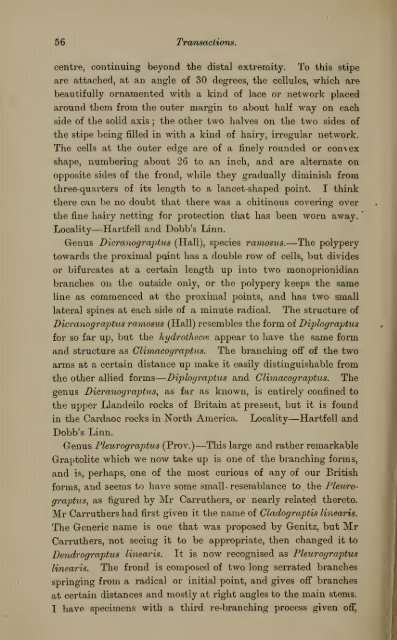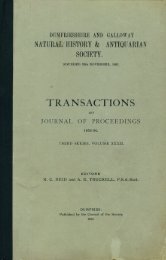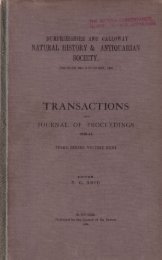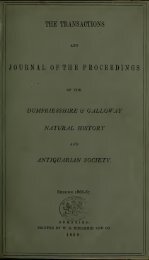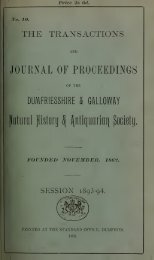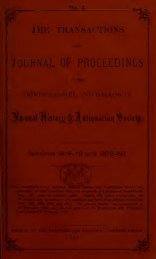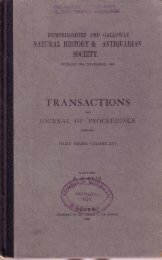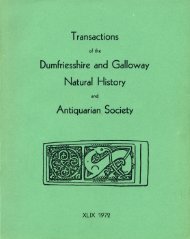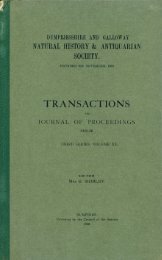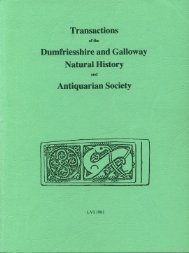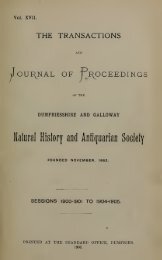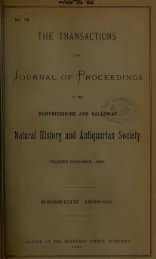Vol 5 - Dumfriesshire & Galloway Natural History and Antiquarian ...
Vol 5 - Dumfriesshire & Galloway Natural History and Antiquarian ...
Vol 5 - Dumfriesshire & Galloway Natural History and Antiquarian ...
You also want an ePaper? Increase the reach of your titles
YUMPU automatically turns print PDFs into web optimized ePapers that Google loves.
—resemblance56 Trcmsactions.centre, continuing beyond the distal extremity. To this stipeare attached, at an angle of 30 degrees, the cellules, which arebeautifully ornamented with a kind of lace or netwoi-k placedaround them from the outer margin to about half way on eachside of the solid axis ; the other two halves on the two sides ofthe stipe being filled in witli a kind of hairy, irregular network.The cells at the outer edge are of a finely rounded or convexshape, numbering about 26 to an inch, <strong>and</strong> are alternate onopposite sides of the frond, while they gradually diminish fromthree-quarters of its length to a lancet-shaped point. I thinkthere can be no doubt that there was a chitinouscovering overthe fine hairy netting for protection that has been worn away. 'Locality—Hartfell <strong>and</strong> Dobb's Linn.Genus Dicranograptus (Hall), species ramosus.—The polyperytowards the proximal point has a double row of cells, but dividesor bifurcates at a certain length up into two monoprionidianbranches on the outside only, or the polypery keeps the sameline as commenced at the proximal points, <strong>and</strong> has two smalllateral spines at each side of a minute radical. The structure ofDicranograptus ramosus (Hall) resembles the form of Diplograptusfor so far up, but the hydrothecce appear to have the same form<strong>and</strong> structure as ClimacoyrajJtus. The branching off" of the twoarms at a certain distance up make it easily distinguishable fromthe other allied forms Di2)loyraptus <strong>and</strong> Clhnacograptus. Thegenus Dicraoiograptus, as far as known, is entirely confined tothe upper Ll<strong>and</strong>eilo rocks of Britain at present, but it is foundin the Cardaoc rocks in North America.Locality—Hartfell <strong>and</strong>Dobb's Linn.Genus Pleurograjytus (Prov.)—Tliis large <strong>and</strong> rather remarkableGraptolite which we now take up is one of the branching forms,<strong>and</strong> is, perhaps, one of the most curious of any of our Britishforms, <strong>and</strong> seems to have some small •to .the Fleurograptus,as figured by Mr Carruthers, or nearly related thereto.Mr Carruthers had first given it the name of Cladograptis linearis.The Generic name is oae that was proposed by Genitz, but MrCarruthers, not seeing it to be appropriate, then changed it toDendrograptus linearis. It is now recognised as Pleurograptuslinearis. The frond is composed of two long serrated branchesspringing from a radical or initial point, <strong>and</strong> gives off branchesat certain distances <strong>and</strong> mostly at right angles to the main stems.I have specimens with a third re-branching process given off.


